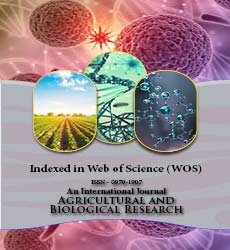Agricultural and Biological Research
RNI # 24/103/2012-R1
Mounika K* and Archana Giri
The development of biotechnology and agriculture relies heavily on callus culture, an integral part of plant tissue culture, Conserve and improve economically and ecologically significant plant species by advancing our understanding of plant physiology and biochemistry and facilitating the rapid propagation of clones. Plant tissue culture has emerged as a feasible method for producing chemicals and the elicitation methodology can aid in their synthesis. Alpinia purpurata, a member of the Zingiberaceae family, is a useful medicinal herb and having a property against cancer, free radicals, and bacteria are among them.
In this study, A. purpurata in vitro callus cultures were subjected to elicitation treatment for four weeks, during which time the effects of Methyl Jasmonate (MJ) and Salicylic Acid (SA) as elicitors were examined. As a part of the post-elicitation analysis, methanol was extracted from the dried callus. Both the nature of the elicitor and the length of time that it was present had significant effects on the measurable outcomes. Overall, treatment groups showed a considerable improvement in flavonoids synthesis compared to the control group. After 21 days of elicitation with a specific quantity of MJ, the highest levels of three flavonoids were found, as quantified by High Performance Liquid Chromatography (HPLC) analysis. Myricetin (489.90 ± 5.99 µg/g DW), Quercetin (994.22 ± 2.15 µg/g DW) and Kaempferol (120.12 ± 2.12 µg/g DW) concentrations were determined. All three flavonoids exhibited a threefold rise and 100 M in MJ concentration compared to the control group. Myricetin (244.62 ± 3.18 µg/g DW), Quercetin (446.53 ± 2.25 µg/g DW), and Kaempferol (60.80 ± 1.21 µg/g DW) all increased by more than 1.5-fold with 50 µM SA as compared to the control group after induction. Based on this research, we may conclude that MJ is a more potent elicitor than SA at promoting flavonoid production in A. purpurata callus cultures.
